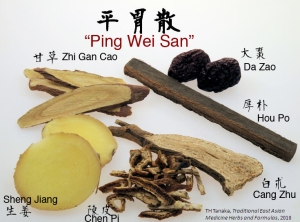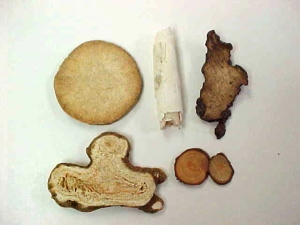All them are Bitter and Cold.
1. Huang Qin Radix Scutellariae

Properties: Bitter, Cold. Root.
Channels entered: Lung, Large Intestine, Stomach, Gallbladder. Strong effect in upper Jiao.
Actions and Indications:
- Clears Heat and drains Dampness: use for interior Damp-Heat in Stomach, Large Intestine, Gallbladder or Lower Jiao. Jaundice, urinary tract infections, smelly burning diarrhea, overflowing edema in the legs, tidal fever worst in the afternoons.
- Drains Fire and relieves toxicity: Heat entering Qi level. High fever, irritability, thirst. Swollen and sore throat, cough with yellow sputum, yellow nasal discharge, red tongue with yellow coat.
- Cools Blood and stops bleeding: bleeding due to Blood Heat. Coughing with Blood streaking sputum, spitting-up Blood.
- Clears Heat and calms fetus: fetus is restless or kicking excessively due to Heat.
Dosage: 3-10g. Use charred (Tan) to stop bleeding. Use wine fried (Jiu) to treat upper parts of the body. Use raw (Sheng) to clear Heat without Dampness. Use dry-fried (Zhi) to calm fetus. Strong effect in upper Jiao.
Caution: Spleen and Stomach deficiency, loose stool.
2. Huang Lian Rhizoma Coptidis

Properties: Bitter, Cold.
Channels entered: Heart, Liver, Stomach, Large Intestine. Strong effect in middle Jiao.
Actions and Indications:
- Clears Heat and dries Dampness: Damp-Heat in Stomach and Large Intestine with diarrhea, dysenteric disorder, or acid regurgitation. Digestive dysfunction due to Stomach Fire.
- Drains Fire and relieves toxicity: carbuncles, lesions, toxic swellings. Red and painful eyes and ulceration of the tongue and mouth.
- Clears Heat and stops bleeding: bleeding due to Blood Heat.
- Clears Heart and Liver Fire: Heat with blazing Fire with symptoms like high fever, irritability. Miscommunication between Heart & Kidney, thirst, insomnia, irritability, dizziness, photophobia, headache, red face and eyes.
Dosage: 1.5-9g.
Caution: Stomach and Spleen deficiency, Yin deficiency and fluid damage.
3. Huang Bai Cortex Phellodendri

Properties: Bitter, Cold.
Channels entered: Kidney, Bladder (lower Jiao).
Actions and Indications:
- Drains Damp-Heat from the lower Jiao: hot Lin syndrome, thick yellow vaginal discharge, foul smelling diarrhea, dysentery.
- Drains Fire and relieves toxicity: Fire toxin-generated sores, Damp skin lesions.
- Drains Kidney Fire: ascending Kidney Fire due to Yin deficiency, insomnia, night sweats, steaming bone disorder, spermatorrhea or nocturnal emission, afternoon fevers.
Dosage: 3-12g.
Caution: Spleen and Stomach deficiency.
4. Long Dan Cao “Dragon Gallbladder grass” Radix Gentianae

Properties: Bitter, Cold.
Part used: Root.
Channels entered: Liver, Gallbladder.
Actions and Indications:
- Drains Damp-Heat from Liver and Gallbladder channel: red, swollen throat and eyes; swollen painful ears or sudden deafness; jaundice; bitter taste in mouth; heavy sensation; pain, swelling and Dampness in genital area; foul smelling vaginal discharge and itching; eczema. Used in Long Dan Xie Gan Tang “Gentiana Long Gan Cao decoction” to drain the Liver and Gallbladder for both Damp-Heat or excessive Heat or Fire. This formula includes Long Dan Cao, Chai Hu, Sheng Di Huang, Zhi Zi and Huang Qin.
- Drains and pacifies excessive Liver and Gallbladder Fire: headache with red eyes; short temper; hypochondriac pain; Liver Wind-Heat causing spasms, convulsions, flank pain, high fever or tremors because lack of fluids can’t nourish sinews.
Dosage: 3-9g.
Caution: Spleen and Stomach deficiency, but 1g. before each meal helps to improve digestion.
5. Qin Pi Cortex Fraxini

Properties: Bitter, Cold, astringent.
Part used: Bark.
Channels entered: Gallbladder, Large Intestine, Liver, Stomach.
Actions and Indications:
- Clear Heat, resolve toxicity, dry Dampness: particularly used for bloody dysenteric disorder in combination with Bai Tou Wang; foul smelling yellow vaginal discharge, yellow greasy tongue coat. Used in Bai Tou Tang to treat dysentry or diarrhea due to Damp-Heat.
- Drains Liver Fire and benefits the eyes: red, swollen painful eyes, tearing.
- Calms wheezing and stop cough: clears Lung Heat and causes Lung Qi to descend, cough, wheezing.
Dosage: 6-12g.
Caution: Spleen and Stomach deficiency Cold.
6. Ku Shen “bitter root” Radix Sophorae Flavescentis
Properties: Bitter, Cold.
Part used: Root.
Channels entered: Heart, Liver, Bladder, Large and Small Intestines.
Actions and Indications: An herb to clear Heat and dry Dampness, particularly good with infestations and lesions like scabies and eczema.
- Clears Heat and dries Dampness: sores, dysenteric disorder, vaginal discharge, jaundice.
- Disperses Wind, kills parasites, and stops itching: Damp toxin skin lesions or infestations with chronic itching. Vaginal discharge & tricomonas vaginitis. Eczema, scabies, infestations and lesions.
- Clears Heat and promotes urination: painful urinary dysfunction due to Damp-Heat in Small Intestine and Bladder. Hot Lin, bloody Lin, stony Lin, turbid Lin syndromes.
Dosage: 3-9g.
Cautions: Incompatible with Li Lu











